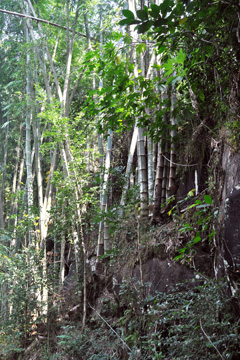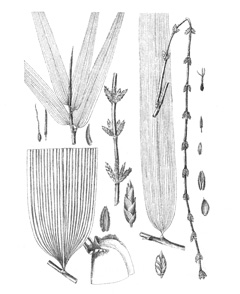 |
|
https://edibleplants.org/ |
 |
| https://edibleplants.org/ |
Translate this page:
Summary
Dendrocalamus asper or commonly known as Giant Bamboo or Rough Bamboo is a very large, dense-clumping, evergreen species native to Southeast Asia. It grows up to 20 m tall and 12 cm in diameter. Younger plants are covered with fine velvety brown hairs. The nodes are swollen; younger nodes have many aerial roots while middle and upper nodes have branches. It is widely cultivated for its highly valued culms that are used as building material and its shoots that are used as vegetable. Upper internodes of the culm are used as containers for water or to collect juice being tapped from palm inflorescence. It can be grown from rhizomes, culm or branch cuttings.
Physical Characteristics

 Dendrocalamus_asper is an evergreen Bamboo growing to 15 m (49ft) by 5 m (16ft) at a fast rate.
Dendrocalamus_asper is an evergreen Bamboo growing to 15 m (49ft) by 5 m (16ft) at a fast rate.
See above for USDA hardiness. It is hardy to UK zone 10. The flowers are pollinated by Wind. The plant is self-fertile.
It is noted for attracting wildlife.
Suitable for: light (sandy), medium (loamy) and heavy (clay) soils and prefers well-drained soil. Suitable pH: mildly acid, neutral and basic (mildly alkaline) soils and can grow in very acid and very alkaline soils.
It cannot grow in the shade. It prefers moist soil.
UK Hardiness Map
US Hardiness Map
Synonyms
Arundarbor bitung (Schult.) Kuntze Arundo aspera (Schult.f.) Oken Arundo piscatoria Lour. Bambusa as
Plant Habitats
Edible Uses
Young stems - cooked. Free of bitterness[ 310 ]. Harvested before they emerge from the soil, they are tender and sweet[ 301 , 310 ]. They are used as a vegetable, pickled or preserved[ 301 ]. They can be cut into strips and used as a substitute for macaroni in soups[ 301 ]. The edible portion of young shoots is about 34%; they weigh on average 5.4 kilos before peeling and 1.8 kilos after peeling[ 299 ].
References More on Edible Uses
Medicinal Uses
Plants For A Future can not take any responsibility for any adverse effects from the use of plants. Always seek advice from a professional before using a plant medicinally.
None known
References More on Medicinal Uses
The Bookshop: Edible Plant Books
Our Latest books on Perennial Plants For Food Forests and Permaculture Gardens in paperback or digital formats.

Edible Tropical Plants
Food Forest Plants for Hotter Conditions: 250+ Plants For Tropical Food Forests & Permaculture Gardens.
More

Edible Temperate Plants
Plants for Your Food Forest: 500 Plants for Temperate Food Forests & Permaculture Gardens.
More

More Books
PFAF have eight books available in paperback and digital formats. Browse the shop for more information.
Shop Now
Other Uses
Other Uses: The upper internodes of the culm, which are longer than the lowermost ones, are used as containers for water or to collect juice being tapped from palm inflorescences[ 310 ]. The internodes of this and other bamboo species are also used as ready-made cooking pots in the field[ 299 , 310 ]. The internode is opened at one end (or the node) and filled with vegetables, meat or rice, and water, and is then covered and placed on a fire[ 310 ]. The culms have thick walls and are very strong and durable. They are used as building material for houses and bridges, for making furniture, boards, musical instruments, household utensils, crafts, outriggers of fishing boats and for paper making[ 299 , 310 ].
Special Uses
References More on Other Uses
Cultivation details
A plant of moist areas in the tropics and subtropics, where it can be found from low elevations up to 1,500 metres, though it grows best at an elevation of 400 - 500 metres[ 310 , 418 ]. It grows best in areas where annual daytime temperatures are within the range 20 - 27°c, but can tolerate 15 - 34°c[ 418 ]. It prefers a mean annual rainfall in the range 1,800 - 3,600mm, but tolerates 1,200 - 4,500mm[ 418 ]. Succeeds in any type of soil of at least moderate fertility, though it grows better on heavy soils with good drainage[ 310 , 418 ]. In Thailand, according to local farmers, the plant will grow well on sandy and rather acidic soils[ 310 ]. Prefers a pH in the range 5 - 6.5, tolerating 4.5 - 7[ 418 ]. Bamboos have an interesting method of growth. Each plant produces a number of new stems annually - these stems grow to their maximum height in their first year of growth, subsequent growth in the stem being limited to the production of new side branches and leaves. In the case of some mature tropical species the new stem could be as much as 30 metres tall, with daily increases in height of 30cm or more during their peak growth time. This makes them some of the fastest-growing species in the world[ K ]. Initially, a young plant raised from a lateral branch cutting will produce small shoots which will develop into small culms[ 310 ]. As the plant grows older, so the culms produced each year increase in size and quantity until full-size culms appear five or six years after planting[ 310 ]. A mature clump may attain a diameter of 3 metres or more and contains about 60 culms[ 310 ]. A culm becomes mature when 3 - 4 years old[ 310 ]. A good healthy clump can produce several shoots annually[ 310 ]. Yields of 10 - 11 tonnes per hectare of bamboo shoots have been reported from Thailand[ 418 ]. Bamboos in general are usually monocarpic, living for many years before flowering, then flowering and seeding profusely for a period of 1 - 3 years before usually dying. This species usually flowers when around 100 - 120 years old[ 299 ].
References Carbon Farming Information and Carbon Sequestration Information
Temperature Converter
Type a value in the Celsius field to convert the value to Fahrenheit:
Fahrenheit:
The PFAF Bookshop
Plants For A Future have a number of books available in paperback and digital form. Book titles include Edible Plants, Edible Perennials, Edible Trees,Edible Shrubs, Woodland Gardening, and Temperate Food Forest Plants. Our new book is Food Forest Plants For Hotter Conditions (Tropical and Sub-Tropical).
Shop Now
Plant Propagation
Seed - sow in containers and only just cover. Germination usually takes place readily. Prick out into individual pots as soon as the plants are large enough to handle. Plant out into permanent positions when 20cm tall. Plants may remain in their low-growing juvenile state for several years - cutting the culms to the ground level can stimulate taller adult growth[ 200 ]. Rhizome, culm and branch cuttings[ 310 ]. The propagules are raised in the nursery and after they have produced roots they are planted out in the field before or during the first half of the rainy season[ 310 ].
Other Names
If available other names are mentioned here
Native Range
TROPICAL ASIA: Andaman Islands, Bangladesh, Borneo, China South-Central, China Southeast, Jawa (Java, an island in Indonesia), Laos, Lesser Sunda Islands, Malaya (Peninsular Malaysia), Maluku (Moluccas, Indonesia), Myanmar (Burma), Philippines, Sulawesi (Celebes, Indonesia), Sumatera (Sumatra, Indonesia), Taiwan, Thailand, Vietnam, AUSTRALASIA: New Guinea (including Papua New Guinea and West Papua)
Weed Potential
Right plant wrong place. We are currently updating this section.
Please note that a plant may be invasive in one area but may not in your area so it's worth checking.
Conservation Status
IUCN Red List of Threatened Plants Status : This taxon has not yet been assessed.

Growth: S = slow M = medium F = fast. Soil: L = light (sandy) M = medium H = heavy (clay). pH: A = acid N = neutral B = basic (alkaline). Shade: F = full shade S = semi-shade N = no shade. Moisture: D = dry M = Moist We = wet Wa = water.
Now available:
Food Forest Plants for Mediterranean Conditions
350+ Perennial Plants For Mediterranean and Drier Food Forests and Permaculture Gardens.
[Paperback and eBook]
This is the third in Plants For A Future's series of plant guides for food forests tailored to
specific climate zones. Following volumes on temperate and tropical ecosystems, this book focuses
on species suited to Mediterranean conditions—regions with hot, dry summers and cool, wet winters,
often facing the added challenge of climate change.
Read More
Expert comment
Author
(Schult.) Backer
Botanical References
Links / References
For a list of references used on this page please go here
A special thanks to Ken Fern for some of the information used on this page.
Readers comment
| Add a comment |
|
If you have important information about this plant that may help other users please add a comment or link below. Only comments or links that are felt to be directly relevant to a plant will be included. If you think a comment/link or information contained on this page is inaccurate or misleading we would welcome your feedback at [email protected]. If you have questions about a plant please use the Forum on this website as we do not have the resources to answer questions ourselves.
* Please note: the comments by website users are not necessarily those held by PFAF and may give misleading or inaccurate information.
To leave a comment please Register or login here All comments need to be approved so will not appear immediately.
|
Subject : Dendrocalamus_asper
|
|
|
|